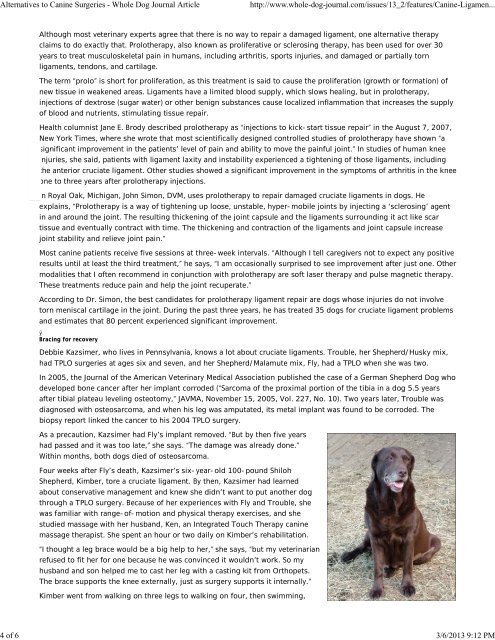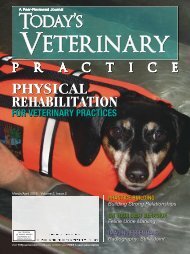<strong>Alternatives</strong> <strong>to</strong> <strong>Canine</strong> <strong>Surgeries</strong> - Whole Dog Journal Articlehttp://www.whole-dog-journal.com/issues/13_2/features/<strong>Canine</strong>-Ligamen...4 of 6 3/6/2013 9:12 PMAlthough most veterinary experts agree that there is no way <strong>to</strong> repair a damaged ligament, one alternative therapyclaims <strong>to</strong> do exactly that. Prolotherapy, also known as proliferative or sclerosing therapy, has been used for over 30years <strong>to</strong> treat musculoskeletal pain in humans, including arthritis, sports injuries, and damaged or partially <strong>to</strong>rnligaments, tendons, and cartilage.The term “prolo” is short for proliferation, as this treatment is said <strong>to</strong> cause the proliferation (growth or formation) ofnew tissue in weakened areas. Ligaments have a limited blood supply, which slows healing, but in prolotherapy,injections of dextrose (sugar water) or other benign substances cause localized inflammation that increases the supplyof blood and nutrients, stimulating tissue repair.Health columnist Jane E. Brody described prolotherapy as “injections <strong>to</strong> kick-start tissue repair” in the August 7, 2007,New York Times, where she wrote that most scientifically designed controlled studies of prolotherapy have shown “asignificant improvement in the patients’ level of pain and ability <strong>to</strong> move the painful joint.” In studies of human kneeinjuries, she said, patients with ligament laxity and instability experienced a tightening of those ligaments, includingthe anterior cruciate ligament. Other studies showed a significant improvement in the symp<strong>to</strong>ms of arthritis in the kneeone <strong>to</strong> three years after prolotherapy injections.In Royal Oak, Michigan, John Simon, DVM, uses prolotherapy <strong>to</strong> repair damaged cruciate ligaments in dogs. Heexplains, “Prolotherapy is a way of tightening up loose, unstable, hyper-mobile joints by injecting a ‘sclerosing’ agentin and around the joint. The resulting thickening of the joint capsule and the ligaments surrounding it act like scartissue and eventually contract with time. The thickening and contraction of the ligaments and joint capsule increasejoint stability and relieve joint pain.”Most canine patients receive five sessions at three-week intervals. “Although I tell caregivers not <strong>to</strong> expect any positiveresults until at least the third treatment,” he says, “I am occasionally surprised <strong>to</strong> see improvement after just one. Othermodalities that I often recommend in conjunction with prolotherapy are soft laser therapy and pulse magnetic therapy.These treatments reduce pain and help the joint recuperate.”According <strong>to</strong> Dr. Simon, the best candidates for prolotherapy ligament repair are dogs whose injuries do not involve<strong>to</strong>rn meniscal cartilage in the joint. During the past three years, he has treated 35 dogs for cruciate ligament problemsand estimates that 80 percent experienced significant improvement.ýBracing for recoveryDebbie Kazsimer, who lives in Pennsylvania, knows a lot about cruciate ligaments. Trouble, her Shepherd/Husky mix,had TPLO surgeries at ages six and seven, and her Shepherd/Malamute mix, Fly, had a TPLO when she was two.In 2005, the Journal of the American Veterinary Medical Association published the case of a German Shepherd Dog whodeveloped bone cancer after her implant corroded (“Sarcoma of the proximal portion of the tibia in a dog 5.5 yearsafter tibial plateau leveling osteo<strong>to</strong>my,” JAVMA, November 15, 2005, Vol. 227, No. 10). Two years later, Trouble wasdiagnosed with osteosarcoma, and when his leg was amputated, its metal implant was found <strong>to</strong> be corroded. Thebiopsy report linked the cancer <strong>to</strong> his 2004 TPLO surgery.As a precaution, Kazsimer had Fly’s implant removed. “But by then five yearshad passed and it was <strong>to</strong>o late,” she says. “The damage was already done.”Within months, both dogs died of osteosarcoma.Four weeks after Fly’s death, Kazsimer’s six-year-old 100-pound ShilohShepherd, Kimber, <strong>to</strong>re a cruciate ligament. By then, Kazsimer had learnedabout conservative management and knew she didn’t want <strong>to</strong> put another dogthrough a TPLO surgery. Because of her experiences with Fly and Trouble, shewas familiar with range-of-motion and physical therapy exercises, and shestudied massage with her husband, Ken, an Integrated Touch Therapy caninemassage therapist. She spent an hour or two daily on Kimber’s rehabilitation.“I thought a leg brace would be a big help <strong>to</strong> her,” she says, “but my veterinarianrefused <strong>to</strong> fit her for one because he was convinced it wouldn’t work. So myhusband and son helped me <strong>to</strong> cast her leg with a casting kit from Orthopets.The brace supports the knee externally, just as surgery supports it internally.”Kimber went from walking on three legs <strong>to</strong> walking on four, then swimming,
<strong>Alternatives</strong> <strong>to</strong> <strong>Canine</strong> <strong>Surgeries</strong> - Whole Dog Journal Articlehttp://www.whole-dog-journal.com/issues/13_2/features/<strong>Canine</strong>-Ligamen...5 of 6 3/6/2013 9:12 PMthen finally bearing full weight on her leg. Eight months after her injury,Kimber’s regimen of supplements, physical therapy, massage, swimming, andNutmeg recovered from two ACL tears without surgery.wearing the brace have enabled her <strong>to</strong> recover well without surgery. “She runs around like a wild girl!” says Kazsimer,who has posted videos of Kimber online, where you can see her running, swimming, and playing with and without herbrace on. “It’s wonderful,” she says. “Kimber is able <strong>to</strong> do everything she did before she got hurt.”Holistic therapiesThe most popular “hands-on” treatments for injured dogs include acupuncture, acupressure, chiropractic, andmassage.Dr. Hershman, a certified veterinary acupuncturist, treats patients with acupuncture <strong>to</strong> alleviate pain and enhancehealing of the <strong>to</strong>rn ligament. “I do this once or twice per week for the first two weeks,” she says, “depending on thedog’s level of pain, then once a week for five <strong>to</strong> six weeks, then once every two weeks, and finally once a month. Whenthe dog is weight-bearing and in less pain, I s<strong>to</strong>p.” Dr. Hershman is also a certified veterinary homeopath whoprescribes homeopathic remedies according <strong>to</strong> the patient’s symp<strong>to</strong>ms.In their article “Post-op Acupressure” (August 2006), Nancy Zidonis and Amy Snow describe how stimulating specificacupressure points with a thumb or fingertip can help with pain management, clear the effects of anesthesia, minimizethe building of scar tissue, and reduce swelling. Acupressure can be learned at home and applied whenever needed.Veterinary chiroprac<strong>to</strong>rs help speed the healing of injuries and surgeries by making adjustments that improve skeletalalignment and musculoskeletal function. (See “Chiroprac<strong>to</strong>rs for <strong>Canine</strong>s,” March 2008.) Chiropractic adjustments helpres<strong>to</strong>re normal nerve activity by gently moving bones, ligaments, and tendons back in<strong>to</strong> alignment, and when ligamentsare injured, adjustments help realign the body <strong>to</strong> improve balance and speed healing.<strong>Canine</strong> massage therapists used <strong>to</strong> be unusual, but now they play an important role in maintaining and improving ourdogs’ health. Efflurage, passive <strong>to</strong>uch, kneading techniques, and stroking increase circulation, release muscle tension,reduce pain and soreness, relieve stress, and accelerate the repair process. Massage books and how-<strong>to</strong> videos make iteasy for caregivers <strong>to</strong> apply these same techniques at home.Online supportThanks <strong>to</strong> the Internet, anyone whose dog suffers a cruciate ligament injury can find a wealth of information aboutcanine ana<strong>to</strong>my, surgical options, and alternative therapies online.The conservative management forum that Faith Rubenstein founded five years ago now has more than 2,000 membersaround the world. Paola Ferraris, who lives in Italy, is one of its modera<strong>to</strong>rs. “What I would like <strong>to</strong> stress is thatconservative management is not an easy (and often not cheap) alternative <strong>to</strong> surgery,” says Ferraris. “Successfulconservative management requires just as much commitment as post-op care. It’s <strong>to</strong>ugh love and careful management.Your work is basically the same as rehabbing a dog who has had surgery; in fact, a number of our members have hadsurgery done on their dogs and use the list for pre-op and post-op support.”When her own dog suffered a ligament injury, Ferraris had <strong>to</strong> make decisions with little information. “The best way <strong>to</strong>discuss treatment with your veterinarian is when you understand the available options and their pros and cons,” shesays. “I had <strong>to</strong> educate myself by spending nights doing research online, after the fact. I would have appreciated havingmore available information, which is what we now offer.”Co-modera<strong>to</strong>r Ansley New<strong>to</strong>n of Pownal, Maine, became interested in conservative management when her chocolateLab, Dooley, injured his second knee. “The first knee had TPLO surgery,” she says, “so I was excited <strong>to</strong> try conservativemanagement with the second knee.Unfortunately after four months he did not get better and I chose <strong>to</strong> have a traditional surgery, which was verysuccessful for this 90-pound dog. Then one day my large chocolate Lab, Nutmeg, came inside with that familiar limp. Iagain decided <strong>to</strong> try conservative management along with a knee brace, acupuncture, massage, swimming, and someother supportive techniques. Within six months she was back <strong>to</strong> normal with very little arthritis.“After three ligament injuries, I thought I was done. But no, two years later Nutmeg came in limping again. I again wentthe conservative management route and things were going fine until the second month when Nutmeg had an oopsmoment. She was limping again, so I decided <strong>to</strong> do surgery but had <strong>to</strong> postpone it for a couple of months because I<strong>to</strong>re my own anterior cruciate ligament and damaged my meniscus at the same time!“So here I was running a farm by myself on crutches and wearing a knee brace with a dog in a knee brace. What a sightwe both were. I wish I had taken a picture. We were forced <strong>to</strong> stay with conservative management because there was no






